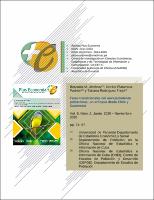Fases transicionales del envejecimiento poblacional, un enfoque desde Chile y Guatemala

Date
2020-12Author
Jiménez, Betzaida M.
Plasencia Padrón, Norkis
Rodríguez Trejo, Tatiana
Plasencia Padró, Norkis
Metadata
Show full item recordAbstract
This paper delves into demographic processes, in order to analyzethe aging process in Chile and Guatemala, two countries in the region that are in different stages from the characterization of the elderly, establishing similarities and differences, with the aim of proposing some public policy actions related to the issue.The low level of fertility and the increase in life expectancy over many years, without substantial variations in other demographic variables, has led to an accelerated increase in the population aged 60 years and over in Latin America and the Caribbean. This process has occurred indistinctly in the countries of the region. Currently the population of Chile and Guatemala show different levels of aging. Its advance, encourages the gradual transformation of public policies that, from different areas of society, try to respond to the demands of the elderly population.Accordingly, the dynamics of the population, its consequences in the change of the age structure, the aging characteristics from the use of several sources are analyzed: Long-term population estimates and projections. 1950-2100, urban-rural and economically active population carried out by CELADE / CEPAL. Population data by age and sex from the Population Censuses of Chile 2017 and Guatemala 2018 were also used, and tabulated from various indicators.The results of this research show the importance of the knowledge of aging by the authorities of both countries for the design and implementation of programs and public policies and the need to incorporate the demographic approach in the actions carried out in order to promote the independence, functionality and quality of life of people who reach those ages. El presente trabajo, profundiza en los procesos demográficos, con el propósito de conocer analizar el proceso de envejecimiento de Chile y Guatemala, dos países de la región que se encuentran en estadios diferentes a partir de la caracterización de las personas de edad, estableciendo similitudes y diferencias, con el objetivo de proponer algunas acciones de políticas públicas vinculadas al tema.El bajo nivel de fecundidad y el aumento de la esperanza de vida a lo largo de muchos años, sin que medien variaciones sustantivas en otras variables demográficas, ha conllevado al aumento acelerado de la población de 60 años y más en América Latina y el Caribe. Este proceso se ha dado de manera indistinta en los países de la región. Actualmente la población de Chile y Guatemala evidencian distintos niveles de envejecimiento. Su avance, propicia la paulatina transformación de políticas públicas que, desde distintos ámbitos de la sociedad, intentan responder a las demandas de la población adulta mayor. De acuerdo con ello, se analiza la dinámica de la población, sus consecuencias en el cambio de la estructura por edades, las características de envejecimiento a partir del empleo de varias fuentes: Estimaciones y proyecciones de población a largo plazo.1950-2100, urbana-rural y Población económicamente activa realizadas por CELADE/CEPAL. También se emplearon datos de la población por edad y sexo de los Censos de Población de Chile 2017 y Guatemala 2018 y tabulados de varios indicadores.Los resultados de esta investigación muestran la importancia del conocimiento del envejecimiento por parte de las autoridades de ambos países para el diseño e implementación de programas y políticas públicas y la necesidad de incorporar el enfoque demográfico en las acciones que se realiza con la finalidad de fomentar la independencia, la funcionalidad y la calidad de vida de las personas que arriban a esas edades.Palabras clave: Demografía, Envejecimiento, Transición demográfica. AbstractThis paper delves into demographic processes, in order to analyzethe aging process in Chile and Guatemala, two countries in the region that are in different stages from the characterization of the elderly, establishing similarities and differences, with the aim of proposing some public policy actions related to the issue.The low level of fertility and the increase in life expectancy over many years, without substantial variations in other demographic variables, has led to an accelerated increase in the population aged 60 years and over in Latin America and the Caribbean. This process has occurred indistinctly in the countries of the region. Currently the population of Chile and Guatemala show different levels of aging. Its advance, encourages the gradual transformation of public policies that, from different areas of society, try to respond to the demands of the elderly population.Accordingly, the dynamics of the population, its consequences in the change of the age structure, the aging characteristics from the use of several sources are analyzed: Long-term population estimates and projections.
URI
http://jadimike.unachi.ac.pa/handle/123456789/709https://revistas.unachi.ac.pa/index.php/pluseconomia/article/view/471
